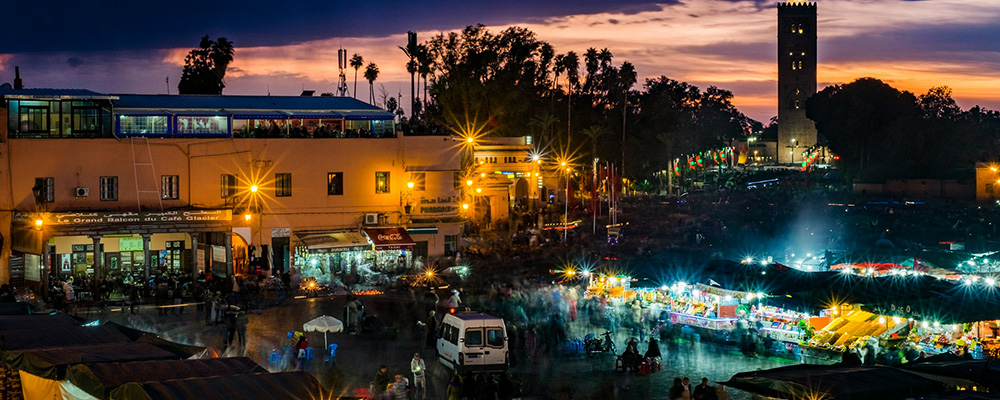
Best Walking Routes in Marrakesh: From Souks to Palaces
Best Walking Routes in Marrakesh: From Souks to Palaces
Marrakesh, the heart of Morocco’s vibrant culture, is best explored on foot. The city’s winding streets, bustling souks, grand palaces, and serene gardens reveal their true magic when you wander them slowly and intimately. Whether you’re a first-time visitor or a returning traveler, knowing the best walking routes will transform your experience, allowing you to immerse yourself fully in the city’s history, artistry, and daily life. This guide takes you on some of the most iconic and authentic routes from the colorful souks to majestic palaces.
1. The Classic Medina Loop: Jemaa el-Fna, Souks & Artisan Quarters
Route highlights:
- Jemaa el-Fna Square
- Souk Semmarine (textiles, spices)
- Souk Ableuh (lemons, olives)
- Artisan workshops in Derb Dabachi
- Mouassine Mosque area
Description:
Start your day at Jemaa el-Fna, Marrakesh’s famous square where the city’s life pulses from dawn to dusk. From there, stroll into the dense maze of souks where merchants sell spices, textiles, leather goods, and traditional crafts. This walking route captures the sensory overload of sights, sounds, and smells — from the colorful spices to the chatter of haggling vendors. Along the way, visit artisanworkshops where craftsmen dye leather, carve wood, or create metalwork. Pause at the Mouassine Mosque area for a quiet moment or a refreshing mint tea at a local café.
Tips:
- Start early to avoid crowds and midday heat.
- Wear comfortable shoes; paths can be uneven.
- Bring cash for purchases and bargaining.
2. The Palaces and Gardens Route: Bahia Palace to Majorelle Garden
Route highlights:
- Bahia Palace
- Saadian Tombs
- Koutoubia Mosque (exterior)
- Majorelle Garden & Yves Saint Laurent Museum (just outside Medina)
Description:
For a blend of history, architecture, and nature, this route showcases Marrakesh’s royal heritage. Begin at the Bahia Palace, a 19th-century masterpiece filled with intricate tilework and lush courtyards. Nearby, explore the Saadian Tombs, a hidden gem rediscovered in the 20th century, boasting stunning Moorish design. Walk past the iconic Koutoubia Mosque, admiring its minaret from the outside (non-Muslims cannot enter). Then, head to the vibrant Majorelle Garden, a peaceful botanical retreat created by French artist Jacques Majorelle and later restored by Yves Saint Laurent. This contrast of bustling Medina and tranquil garden is a perfect walking experience.
Tips:
- Purchase tickets for palaces and gardens in advance during peak season.
- Take water and sun protection for outdoor walking.
- Allocate 3–4 hours for this route to fully enjoy each site.
3. Hidden Gems & Off-the-Beaten-Path Route
Route highlights:
- Le Jardin Secret
- Mellah (old Jewish quarter)
- Dar Si Said Museum
- Local artisan cooperatives
Description:
Explore quieter, less-touristy areas of Marrakesh with this walking route. Le Jardin Secret offers a beautiful restored palace garden blending Islamic and Moroccan design. Nearby, visit the Mellah, Marrakesh’s historic Jewish quarter with its unique architecture and old synagogues. The Dar Si Said Museum showcases Moroccan arts and crafts in a stunning palace setting. Along the way, stop by local cooperatives supporting artisans, where you can see rug weaving, pottery, and other crafts in action.
Tips:
- Hire a knowledgeable local guide to navigate and explain these less obvious sites.
- Be respectful when photographing local neighborhoods and people.
- Look for opportunities to support authentic artisan shops.
4. The Food & Spice Trail: Markets, Stalls & Traditional Eateries
Route highlights:
- Spice Souk
- Rahba Kedima Square
- Street food stalls near Jemaa el-Fna
- Traditional cafés and bakeries
Description:
For food lovers, this walking route is a delicious immersion into Marrakesh’s culinary culture. Wander through the spice souk where piles of turmeric, cumin, saffron, and more create a fragrant mosaic. Visit Rahba Kedima Square, the perfect place to watch sellers and buyers haggle over fresh herbs, nuts, and local ingredients. Sample traditional Moroccan snacks like msemen (flatbread), dates, and fresh juices at street vendors. End your walk at a traditional café or bakery for mint tea and pastries, soaking in the lively atmosphere.
Tips:
- Check for food hygiene and popularity before trying street foods.
- Take a local guide to discover hidden eateries and food stories.
- Carry small change for purchases and tips.
Final Tips for Walking in Marrakesh
- Stay hydrated: The city can be hot and dry, especially in summer.
- Dress modestly: Respect local culture by covering shoulders and knees.
- Use a guide or map: The Medina is a labyrinth; getting lost can be fun but guides add valuable context.
- Start early or late: Avoid midday heat and crowds.
Protect your belongings: Keep valuables secure as crowded areas can be targets for pickpockets.
Conclusion
Marrakesh is a city to be savored step by step. From the bustling souks filled with colors and aromas to the serene palaces and secret gardens, the best walking routes offer a blend of history, culture, and everyday life. Whether wandering solo or with a trusted local guide, these routes ensure you experience Marrakesh’s true essence — a city where every corner tells a story.
Ready to explore Marrakesh on foot?
Book your personalized walking tour now and discover the magic of the Red City like a true local!
.jpeg)